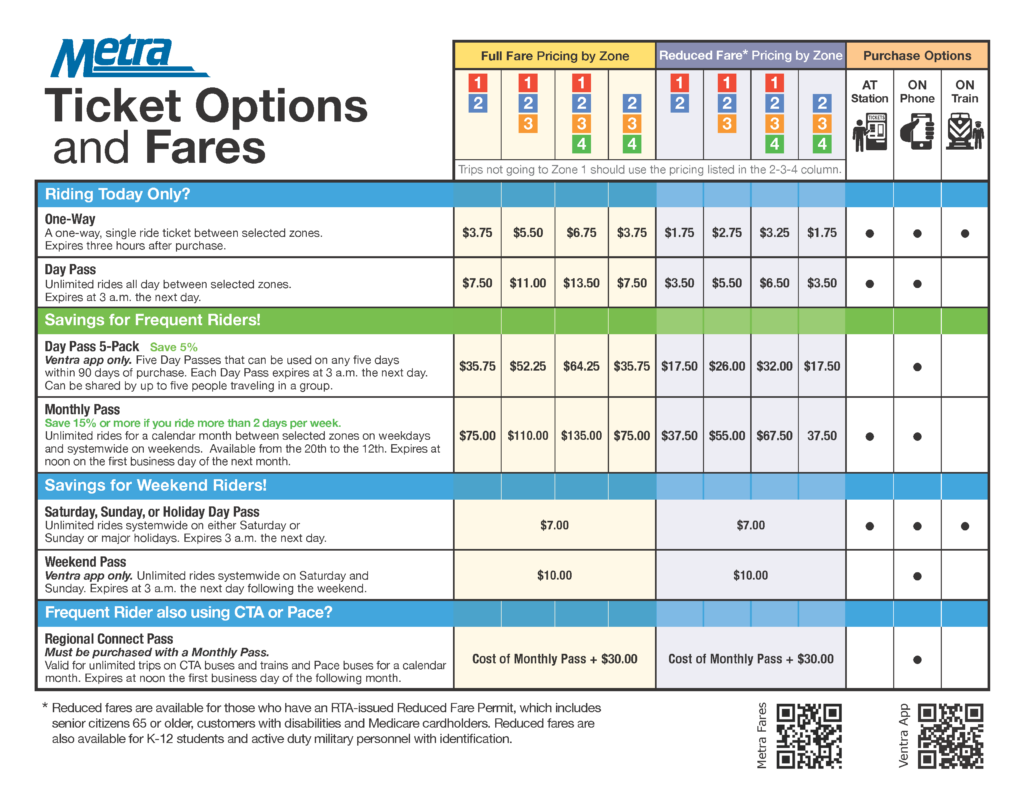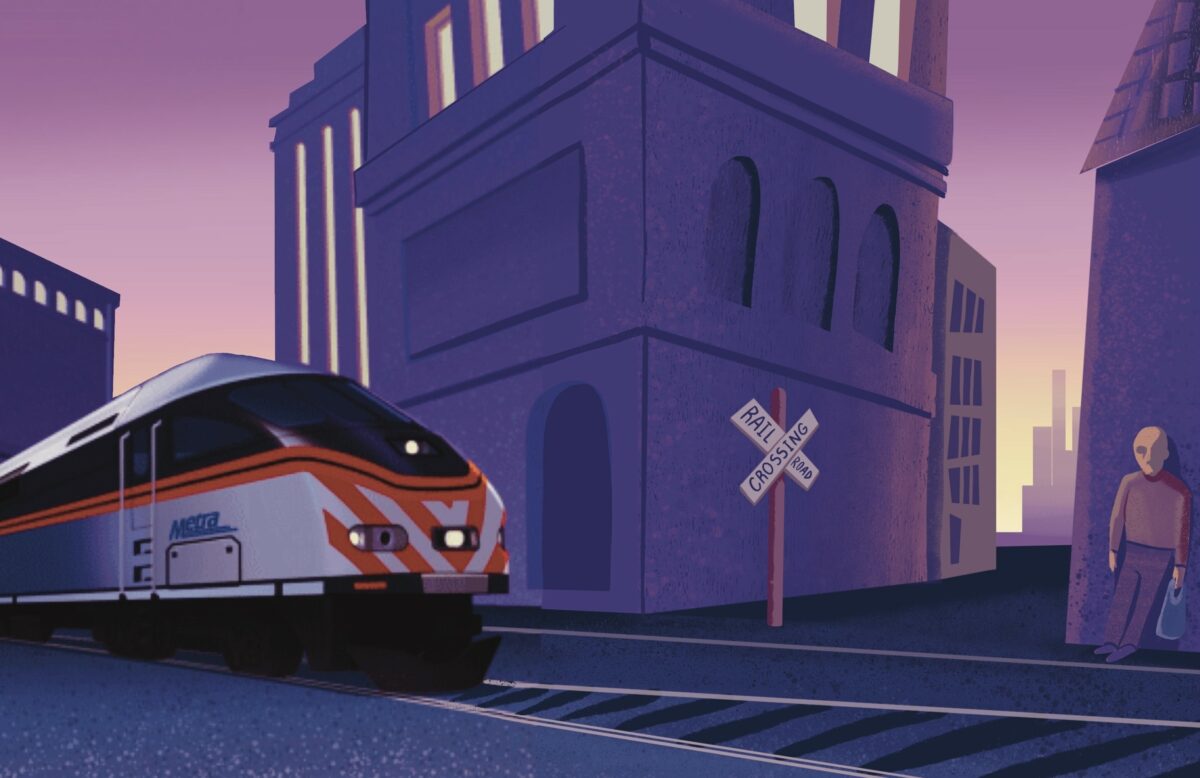As part of its 2024 budget proposal, Metra is envisioning a new way to use its service, including a simplified fare structure. Since June, Metra officials have been asking for community input on a plan to change their current ten-zone fare structure to a more streamlined four-zone structure. Now, with Metra’s 2024 budget proposal available for public comment and up for ratification later this year, that plan is much closer to reality.
Under Metra’s current system, the Chicago metro area is divided into ten different zones. Union Station in the Loop is the hub, with tickets getting progressively more expensive the farther from the city one travels. Currently, the tickets start at $4 and go as high as $9.50 to reach the farthest stations in the suburbs and into Wisconsin and Indiana. In Metra’s simplified proposal, zones would still radiate out from the Loop, but most Chicago stations and nearby suburbs would fall into Zone 2. Under this plan, most trips that depart from within the city and surrounding suburbs would cost $3.75 going into downtown, with fares going up to $5.50 from Zone 3 and $6.75 from Zone 4. Any one-way trips that don’t go in or out of downtown will be $3.75.

One of the more consequential updates included in next year’s budget is Metra’s anticipated elimination of the Fair Transit South Cook pilot program, in which Cook County subsidized half of the fare amount for the Metra Electric and Rock Island lines. Conceived to counter the financial crunch felt by many during the COVID-19 pandemic, the subsidy was introduced by Cook County’s Department of Transportation in January 2021. According to a 2022 report on the pilot, the subsidized lines “recover[ed] ridership faster than the other Metra lines, although by a smaller margin than in the first year of the pilot.” The same report stated that the pilot saw benefits for people from low-income neighborhoods, and that ridership increased relative to 2021.
The Metra Electric is the only Metra line that is completely within city limits, servicing McCormick Place, Hyde Park, and South Chicago, while Rock Island traverses along the Dan Ryan and into parts of Pullman. The Fair Transit South Cook pilot program also increased service on the Pace Route 352 from the 95th Red Line to Harvey and Chicago Heights. A fare that cost $2 with the pilot program subsidy would increase to $3.75, or a dollar less than the pre-pandemic fare.

Michael Gillis, a spokesperson for Metra, said: “Have we seen ridership increasing on those lines, and have we restored service…and the answer to both those questions is yes, and the Fair Transit South Cook pilot program certainly played a role in that. There are days where the Metra Electric Line, as a percentage of pre-COVID ridership, is the most-used line in our system.”
The Cook County Department of Transportation did not respond to multiple requests for comment from the Weekly on the fare caps, Ventra integration, income-based reduced fare, and expanded student pass programs outlined in their Transit Plan. The County does not directly manage the Regional Transportation Authority (RTA), which manages and oversees Metra, Pace, and the Chicago Transit Authority (CTA), but its RTA sales tax is the organization’s greatest source of revenue for the RTA, which includes the Metra. The Cook County Board of Commissioners and its President, Toni Preckwinkle, also appoint the directors to Metra and the RTA.
“The Fair Transit South Cook improved the lives of a lot of people by reducing the barriers to transit usage by cutting the costs in half,” said David Powe, planning director of the Active Transportation Alliance, a Chicago transportation advocacy not-for-profit. But “one issue with the pilot from the start, was that the City of Chicago and CTA did not participate in the pilot at all. And so that really showcases the leadership of our county, Metra and Pace come together to improve the lives of people by reducing these costs.”
Though the stay-at-home orders caused by the COVID-19 pandemic ended long ago, they led to an ongoing shift in how Metra envisions its future. Metra was conceived as a commuter rail where people from the suburbs, who usually worked a traditional 9am–5pm work day, could find reliable service during peak hours. As an official part of its new mission, Metra has included in its 2024 budget a more “regional” approach to public transportation, which would maintain heightened service during peak hours, but where riders could expect more service at regular intervals during non-peak hours. More frequent and regular-interval service has been a demand of many local advocacy groups, including the Coalition for a Modern Metra Electric, which is comprised of member organizations such as the Hyde Park-Kenwood Community Conference and the Active Transportation Alliance. The latter was also part of the Cook County Transit Plan Steering Committee, which released its first-ever transit plan in September 2023.
Another proposal would be to eliminate the current ten-ride ticket option and replace it with five separate day passes. Under the current plan, a rider could purchase ten individual tickets to be used at any time within ninety days. The five day pass model would allow for unlimited rides in a single day with one pass.
In anticipation of a modified service, Metra would also seek better integration with Ventra by expanding the Regional Connect Pass, which offers unlimited CTA and Pace rides for people who purchased a Metra monthly pass and to offer discounts when switching between Metra, Pace, and CTA.
“Their integration is one of our goals,” said Gillis. “But it’s really both a technological and a financial issue. The CTA has turnstiles for a bus operator at every point. And their passengers just have to either tap the Ventra Card to get through the turnstile.” On the Metra, conductors walk down the aisles and either physically punch a paper ticket or visually scan a mobile ticket on a phone. “It’s very difficult to integrate a card like the Ventra Card into a system like ours. There are solutions for how to do that, but they require a lot of infrastructure [and] technological installations to make that work.”
According to the budget, released last week, Metra expects there to be a gap in funding when federal funds such as the CARES Act and the Inflation Reduction Act (IRA) run out in 2026. This means that Metra expects a shortfall in funding that could prevent the increase in service that riders demand.
Organizations like Active Transportation Alliance are putting pressure on the state to provide additional transit funding in the region in order to address the projected shortfall. “We’ll be pushing for that this legislative session based on the recommendations outlined in that plan of action for regional transit,” said Powe. That request for additional funding would be to fund the demand for more frequent services, such as personnel, tracks, and trains.
The current budget is now available for public comment. Virtual public hearings will take place on November 1 and 2, and people can also send in comments via mail, email, and voicemail; more information is available on the Metra website. If approved in their November meeting, it will be sent for a final vote by the RTA board in December, and then go into effect on February 1, 2024.
Francisco Ramírez Pinedo is a freelance journalist based in the Southeast Side.

